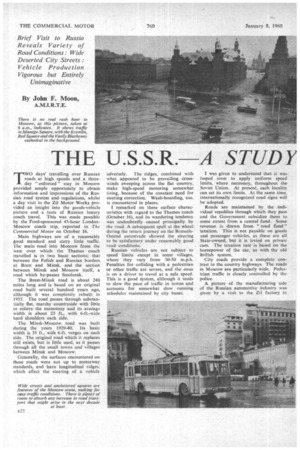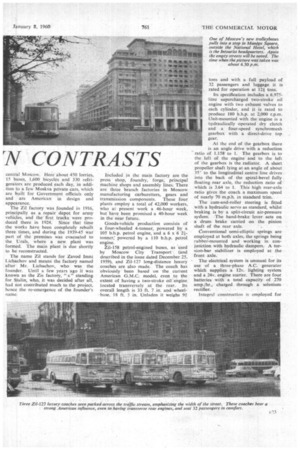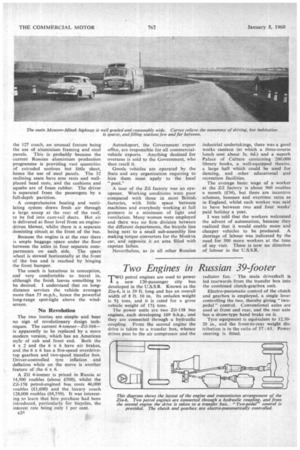THE U.S.S.R. A STUDY 'N CONTRASTS
Page 86

Page 87

Page 88

If you've noticed an error in this article please click here to report it so we can fix it.
Brief Visit to Russia Reveals Variety of Road Conditions: Wide Deserted City Streets : Vehicle Production Vigorous but Entirely Unimaginative By John F. Moon, A.M.I.R.T.E.
TWO days' travelling over Russian roads at high speeds and a threeday " enforced " stay in Moscow provided ample opportunity to obtain information and impressions of the Russian road system and regulations, whilst a day visit to the Zil Motor Works provided an insight into the goods-vehicle picture and a .taste of Russian luxury coach travel. This was made possible by the Ford-sponsored 45-hour LondonMoscow coach trip, reported in The Commercial Motor on October 16.
Main highways are of a reasonably good standard and carry little traffic. The main road into Moscow from the west over which the Thames coach travelled is in two basic sections; that between the Polish and Russian borders at Brest and Minsk, and the section between Minsk and Moscow itself, a road which by-passes Smolensk.
The Brest-Minsk road is about 240 miles long and is based on an original road built several hundred years ago, although it was completely rebuilt in 1955. The road passes through substantially fiat, marshy countryside with little to relieve the monotony and its average width is about 23 ft., with 6-ft.-wide hard shoulders each side.
The Minsk-Moscow road was built during the years 1939-40. Its basic width is 35 ft., with 6-ft, verges on each side. The original road which it replaces still exists, but is little used, as it passes through all the small towns and villages between Minsk and Moscow.
Generally, the surfaces encountered on these roads were not up to motorway standards, and have longitudinal ridges, which affect the steering of a vehicle adversely. The ridges, combined with what appeared to be prevailing Crosswinds sweeping across the flat country, make high-speed motoring somewhat tiring, because of the constant need for steering correction. Wash-boarding, too. is encountered in places.
I remarked on these surface characteristics with regard to the Thames coach (October 16), and its wandering tendency was undoubtedly caused principally by the road. A subsequent spell at the wheel during the return journey on the BrusselsOstend autostrade showed the steering to be satisfactory under reasonably good road conditions.
Russian vehicles are not subject to speed limits except in some villages, where they vary from 30-50 m.p.h. Penalties for colliding with a pedestrian or Other traffic are severe, and the onus is on a driver to travel at a safe speed. This is a good system, although it tends to slow the pace of traffic in towns and accounts for somewhat slow running schedules maintained by city buses. I was given to understand that it was hoped soon to apply uniform speed limits, where necessary, throughout the Soviet Union. At present, each locality can set its own limits. At the same time, internationally recognized road signs will be adopted.
Roads are maintained by the individual republics through which they pass and the Government subsidize them to some extent from a central fund. Some revenue is drawn from "road fund" taxation. This is not payable on goods and passenger vehicles, as these are all State-owned, but it is levied on private cars. The taxation rate is based on the horsepower of the car, as with the old British system.
City roads provide a complete contrast to the country highways. The roads in Moscow are particularly wide. Pedestrian traffic is closely controlled by the A picture of the manufacturing side of the Russian automotive industry was given by a visit to the Zil factory in . central Moscow. Here about 450 lOrries, 15 buses, 1,600 bicycles and 330 refrigerators are produced each day, in addition to a few Moskva private cars, which are built for Government officials only and are American in design and appearance.
The Zil factory was founded in 1916, principally as a repair depot for army vehicles, and the first trucks were produced there in 1924. Since that time the works have been completely rebuilt three times, and during the 1939-45 war part of the premises was evacuated to the Urals, where a new, plant was formed. The main plant is due shortly to be reconstructed.
The name Zil stands for Zavod Imni Lichachov and meanS the factory named after Mr. Lichachov, who was the founder, Until a few years ago it was known as the Zis factory, " s " standing for Stalin, who, it was decided after all, had not contributed much to the project, hence the re-emergence of the founder's name. Included in the main factory are the press shop, foundry, forge, principal machine shops and assembly lines, There are three branch factories in Moscow manufacturing carburetters, gears and transmission components. These four plants employ a total of 42,000 workers, who at present work a 46-hour week, but have been promised a 40-hour week in the near future.
Goods-vehicle 'production consists of a four-wheeled 4-tonner, powered by a 105 b.h.p. petrol engine, and a 6 x 6 24tanner; powered by a 110 b.h.p. petrol engine.
Zil-158 petrol-engined buses, as used by Moscow City Transport (and described in the issue dated December 25. 1959), and Zil-127 long-distance luxury coaches are also made. The coach has obviously been based on the current American G.M.C. model, even to the extent of having a two-stroke oil engine located transversely at the rear. Its overall length is 33 ft. 7 in, and wheel'base. 18 ft. 5 in. Unladen it weighs 9i tons arid with a full payload of 32 passengers and luggage it is rated for operation at 121 tons..
Its specification includes a 6.975litre supercharged two-stroke oil engine with two exhaust valves to each cylinder, and it is rated to produce 180 b.h.p. at 2,000 r.p.m. Unit-mounted with the engine is a hydraulically operated dry clutch and a four-speed synchromesh gearbox with a direct-drive top gear.
At the end of the gearbox there is an angle drive with a reduction ratio of 1.158 to 1. The gearbox is to the left of the engine and to the left of the gearbox is the radiator. A short propeller shaft lying at an angle of about 35° to the longitudinal centre line drives into the back of the spiral-bevel fully floating rear axle, the reduction ratio of which is 3.64 to 1. This high rear-axle ratio gives the coach a maximum speed of nearly 70 m.p.h, in standard trim.
The cam-and-roller steering is fitted with a hydraulic servo as standard, whilst braking is by a split-circuit air-pressure syslem: The hand-brake lever, acts on a drum brake carried on the pinion shaft of the rear axle.
Conventional semi-elliptic springs are employed at both axles, the springs being rubber-mounted and working in conjunction with hydraulic dampers. A torsion-bar stabilizer is employed at the front axle.
The electrical system is unusual for its use of a three-phase A.C. generator which supplies a 12v. lighting system and a 24v. engine starter. There are four batteries with a total capacity of 270 amp./hr,, charged through a selenium • rectifier.
Integral construction is employed for the 127 coach, an unusual feature being the use of aluminium framing and steel panels. This is probably because the current Russian aluminium production programme is providing vast quantities of extruded sections but little sheet, hence the use of steel panels. The 32 reclining seats have arm rests and wellplaced head rests, and the cushions and squabs are of foam rubber. The driver is separated from the passengers by a full-depth partition.
A comprehensive heating and ventilating system draws fresh air through a large scoop at the rear of the roof, to be fed into cant-rail ducts. Hot air is delivered at floor level from an enginedriven blower, whilst there is a separate demisting circuit at the front of the bus.
Because the engine is at the rear there is ample baggage space under the floor between the axles in four separate compartments on each side. The spare wheel is stowed horizontally at the front of the bus and is reached by hinging the front bumper.
The coach is luxurious in conception, and very comfortable to travel in, although the finish leaves something to be desired. I understand that on longdistance services the vehicle averages more than 55 m.p.h., hence the powerful long-range spot-light above the windscreen.
No Revolution The two lorries are simple and bear no sign of revolutionary design techniques. The current 4-tonner—Zi1-164-is apparently to be replaced by a more modern version, which has an American style of cab and front end. Both the 4 x 2 and the 6 x 6 have air brakes, and the 6 x 6 has a five-speed overdrivetop gearbox and two-speed transfer box. Driver-controlled tyre inflation and deflation white on the move is another feature of the 6 x 6.
A Zil 4-tonner is priced in Russia at 14,500 roubles (about £500), whilst the Zil-158 petrol-engined bus costs 46,000 roubles (£1,600) and the luxury coach 128,000 roubles (£4,550). It was interesting to learn that hire purchase had been introduced, particularly for bicycles, the interest rate being only 1 per cent.
24
Autoeksport, the Government export office, are responsible for all commercialvehicle exports. Anything destined for overseas is sold to the Government, who then resell it.
Goods vehicles are operated by the State and any organization requiring to hire them must apply to the local "pool."
A tour of the Zil factory was an eyeopener. Working conditions were poor compared with those in most British, factories, with little space between machines and everybody working at full pressure in a minimum of light and ventilation. Many women were employed and there was no firm division between the different departments, the bicycle line being next to a small sub-assembly line making torque converters for the Moskva car, and opposite it an area filled with capstan lathes.
Nevertheless, as in all other Russian industrial undertakings, there was a good works canteen (at which a three-course lunch cost about 3s. 6cl.) and a superb Palace of Culture containing 200,000 library books, a well-equipped theatre, a large hall which could be used for dancing, and other educational and recreation facilities.
The average basic wage of a worker at the Zil factory is about 960 roubles a month (£34), but there are incentive schemes, bonuses and overtime rates as in England, whilst each worker was said to have between two and four weeks' paid holiday a year.
was told that the workers welcomed the advent of automation, because they realized that it would enable more and cheaper vehicles to he produced. A shortage of labour was indicated by the need for 500 more workers at the time of my visit. There is now no direction of labour in the U.S.S.R. "
























































































































































